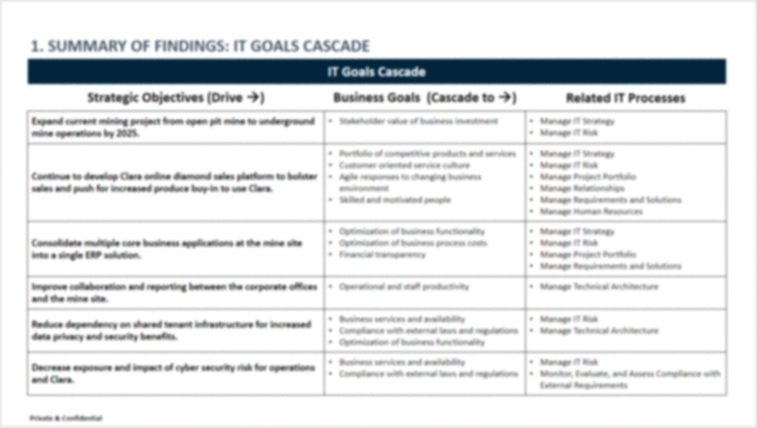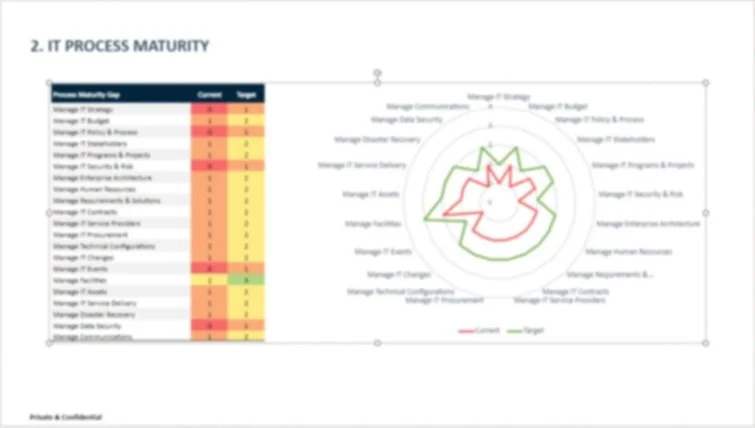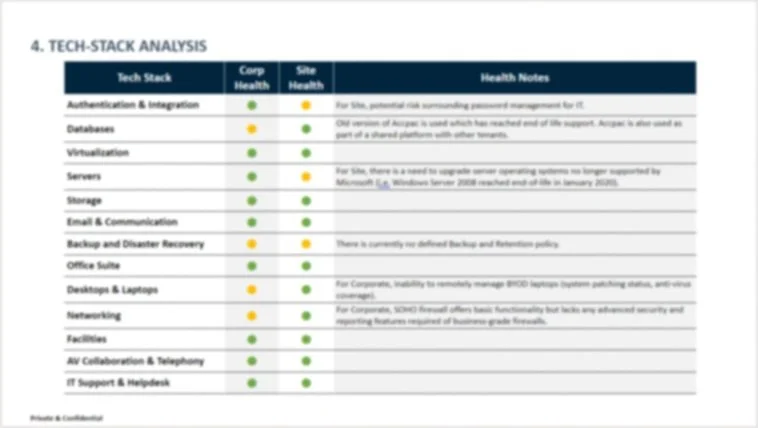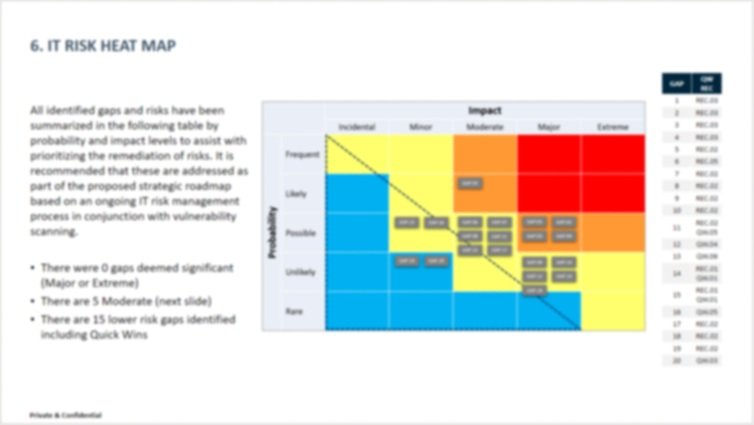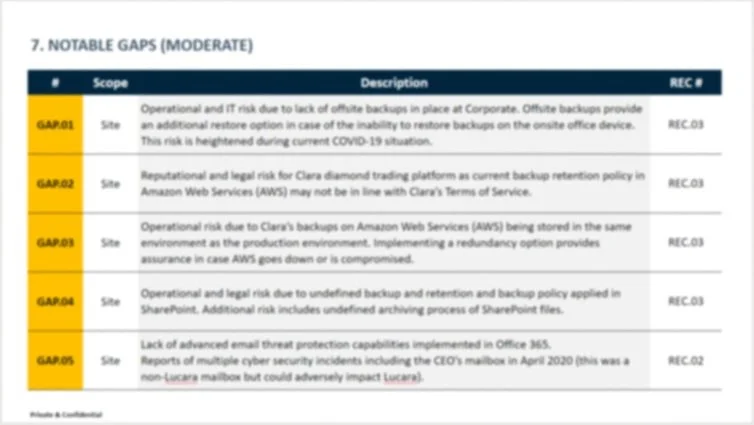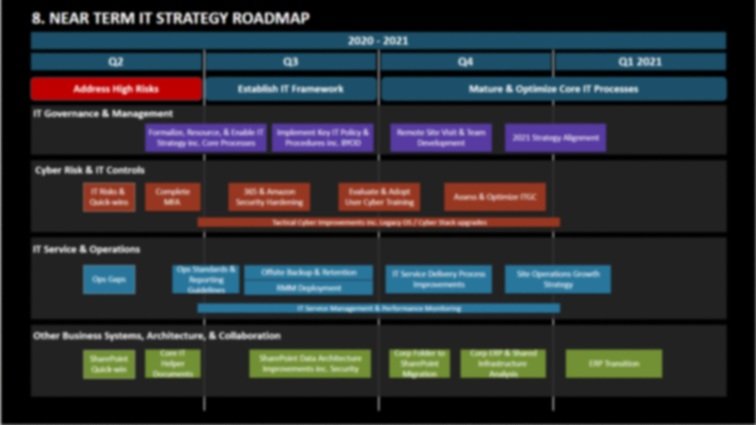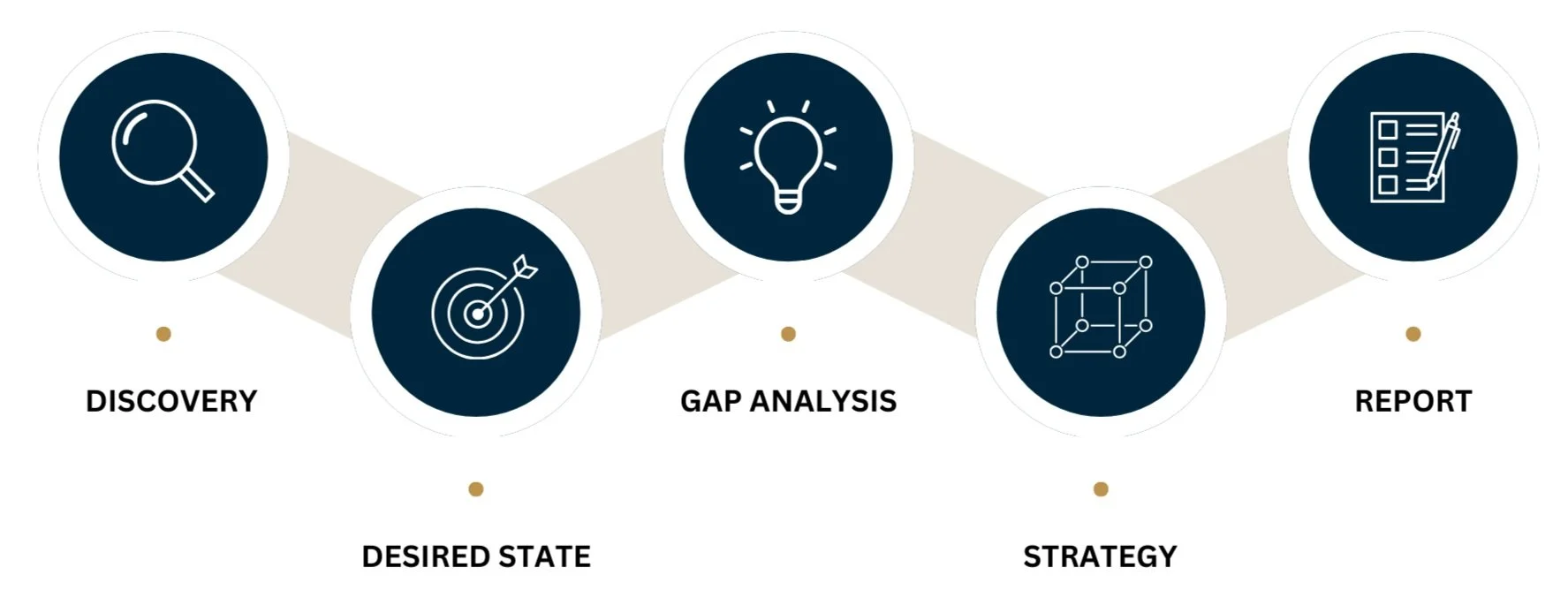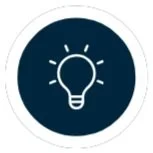Get IT on Target
There is an understanding among business leaders that propelling your business toward substantial growth represents a significant and collective effort by the entire organization. Drawing on our extensive experience in guiding information programs and transformation initiatives, we recognize obstructions to achieving growth and profitability include a number of factors common to many SMEs. These include actual or perceived technical debt, elevated technology expenses, conflicting organizational priorities, lack of capacity and capability, as well as a loss of confidence in a comprehensive strategy that is both future-forward and current state-focused.
The Strategic ITD assessment follows IT Directorship™’s proven 5-step process for efficient and effective evaluation of your IT environment. It equips you with a comprehensive understanding of the current state of IT, a benchmark of performance, a future state vision, and a roadmap of actionable next steps, facilitating more successful outcomes and positioning IT as a strategic lever for business success.
Align IT for long-term success in the digital era.
Why is a Strategic ITD Assessment important for your business?
Conducting a comprehensive assessment is an investment businesses make to strategically evaluate the health of their entire IT environment, resources and process capabilities. A Strategic ITD Assessment aims to ensure a deep understanding of your business goals and give you confidence in your understanding and decision-making when it comes to IT maturity awareness and growth-focused transformation initiatives. Some benefits of this due diligence process include:
 Growth Enabler: A Strategic ITD Assessment provides the required insight to effectively tailor your IT strategy. Aligned with your business goals, this provides your organization with the assurance that your IT infrastructure can scale in tandem with your growth objectives, preventing friction points and avoiding costly errors while maintaining operational optimization.
Growth Enabler: A Strategic ITD Assessment provides the required insight to effectively tailor your IT strategy. Aligned with your business goals, this provides your organization with the assurance that your IT infrastructure can scale in tandem with your growth objectives, preventing friction points and avoiding costly errors while maintaining operational optimization.
 Risk Mitigation: Gain a clear understanding of your current vulnerabilities and overall cyber risk posture, along with an actionable roadmap to minimize the potential for cyber breaches, data loss or system failures, resulting in effective risk mitigation and business resiliency.
Risk Mitigation: Gain a clear understanding of your current vulnerabilities and overall cyber risk posture, along with an actionable roadmap to minimize the potential for cyber breaches, data loss or system failures, resulting in effective risk mitigation and business resiliency.
 Cost Optimization: Improve the cost-effectiveness of your IT environment, identifying opportunities to streamline operations and optimize IT resource allocation, resulting in potential cost savings and improved financial performance.
Cost Optimization: Improve the cost-effectiveness of your IT environment, identifying opportunities to streamline operations and optimize IT resource allocation, resulting in potential cost savings and improved financial performance.
 Increase ROI: Realize value from IT-enabled investments and optimize the use of IT assets to support improved IT governance and project performance.
Increase ROI: Realize value from IT-enabled investments and optimize the use of IT assets to support improved IT governance and project performance.
 Stakeholder Confidence: Equipped with awareness of improvement opportunities and actionable steps to address vulnerabilities provides stakeholders, including clients, investors and partners, with assurance regarding your organization’s level of awareness regarding managing risk.
Stakeholder Confidence: Equipped with awareness of improvement opportunities and actionable steps to address vulnerabilities provides stakeholders, including clients, investors and partners, with assurance regarding your organization’s level of awareness regarding managing risk.
Our Proven 5-Step ITD Assessment Process
IT Directorship™’s 5-step process to completing an expert-led IT assessment is highly structured and designed to thoroughly evaluate your business’s current IT environment and uncover growth opportunities to meet future demands. They deliver crucial insights about IT health, IT processes, IT technologies, and operational IT effectiveness, along with both qualitative and quantitative evaluations of IT performance which enable us to effectively define an actionable roadmap aligned with your business goals and objectives.
Our Strategic ITD Assessment aims to establish a baseline rating on key areas of security, maturity, cyber risk, and overall strategic alignment to highlight gaps and suggest methods for improving performance across the organization. While timeframes are dependent on IT infrastructure complexity and the number of stakeholders involved, typical engagements span 2 – 3 weeks with our dedication to minimizing any disruption to your team.
1.Discovery
The assessment begins with an information request to provide a comprehensive set of documentation and completed questionnaires from key areas of the business, including your technical team(s). This background is key for our team to gain a full understanding of the current state of your IT environment and related services. If any documentation or information isn’t available or current, the topic can be addressed in the in-depth interviews.
-
For full transparency in support of your comprehensive assessment, documentation and IT information requests may include:
• Technology asset inventory
• Current IT policies and procedures (if any) including, but not limited to: incident response plan, disaster recovery plan, and IT security policies.
• Most recent IT operational reporting package / KPIs inc. uptime, systems health, cybersecurity
• Any recent cyber incidents or major outage information including post-incident review reports
Stakeholder Interviews
Throughout this process, we’ll engage in a series of interviews involving key stakeholders and leadership to gain an in-depth understanding of business goals and operational intricacies. A well-organized interview schedule typically explores subjects such as:
• Company background, history, expertise, market, key business metrics, and organizational structure
• Overview of the general technology landscape, identifying key technologies and systems you deem critical to your business operations.
• How is cybersecurity currently managed and what measures are in place to protect against cyber threats and attacks?
• Do you have established internal control measures and governance practices in place?
• Current priorities for technology and known desires not realized current IT environment.
2.Desired State
Upon thorough analysis of the documentation and insights garnered through the discovery phase, the assessment team will craft a future envisioned technology state and business goals objectives. This desired state delineates the existing technological landscape where the issue(s) manifests and its impact on overall business operations and company finances.
-
The structured format guiding the definition of the desired state includes:
• A description of the current state, highlighting growth inhibitors or pain points that act as barriers to growth.
• Business strategic drivers derived from key executive stakeholder interviews.
• A vision for future IT landscape following strategic investment.
• Preliminary recommendations and suggestions for strategic improvements to set you on the path to resiliency and growth enablement.
3.Gap Analysis
Using the findings outlined in the ‘Desired State’, as well as the known business goals acquired through Discovery, the assessment team will conduct an in-depth gap analysis to thoroughly evaluate your existing IT technology stack and line of business applications. This comprehensive review encompasses organizational team structure, overall network architecture, as well as controls and governance mechanisms.
4.Strategy
Following the thorough evaluation of current state tools, technology and operational processes, we’re able to identify gaps and inefficiencies. Measured against your business goals and industry best practices, the gap analysis illuminates recommended remedies and strategic growth enablers. The clarity provided empowers informed decision-making in the prioritization of transformation initiatives to move your organization from current state to desired state.
5.Report & Debrief
Upon completion, you will be presented with a comprehensive report tailored to your organization’s goals and leadership decision-making. A live review is conducted with key stakeholders to review findings uncovered in the assessment and provides an opportunity to openly discuss significant insights, expand on recommendations, gather additional feedback and deliberate on the cost benefit of proposed initiatives. Following the debriefing, the report undergoes finalization, integrating final thoughts and inputs and refining the strategic roadmap.
When is it time to conduct a strategic IT assessment?
Technology is constantly changing which brings numerous benefits as well as increased risks. While ideally, proactive and ongoing, at a minimum, periodic and independent reviews of your technology environment will allow you to track progress and ensure you remain competitive and aligned with the evolving needs and goals of your business. Business drivers which triggers a need for a strategic IT assessment include:
Planning significant business growth or change
Considering an enterprise resource planning “ERP” system
A major IT outage or cybersecurity breach
Exploring M&A opportunities
Preparing to go public
Establishing a performance baseline for continuous improvement
What should you expect during a Strategic ITD Assessment?
As we lead you through the IT assessment process, we take a collaborative and methodical approach. Multiple interviews are conducted with key business stakeholders to garner qualitative data to more accurately assess your experience, expectations and requirements of IT. With the goal of best positioning your organization for long-term success, it is important for everyone involved to embrace transparency and open-mindedness. We take a risk-based approach in assessing your IT environment and prioritize your critical data, systems, and related business workflows. Expect to be kept well informed of the overall assessment project status and any significant risks uncovered along the way. Any changes in schedules or roadblocks preventing timely completion will be discussed and resolved together. Our approach is one of integrity and C.A.R.E.
What are the most common findings of our Strategic ITD Assessments?
Specific findings in final reports vary based on the scope relative to the size of the organization, but common findings include:
Low IT management process maturity prohibiting transformation enablement.
The IT architecture design is not scalable to meet the needs of the long-term business vision
The IT service delivery function does not have service level agreements in line with end user expectations
There is a lack of business continuity, disaster recovery, and cyber incident response capabilities
Business stakeholders needs have not been appropriately documented or understood
Many strategic resourcing and capability gaps can be acquired through our proprietary IT Directorship™ or CyberSurance™ Programs



